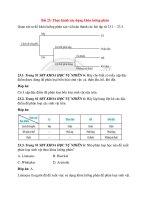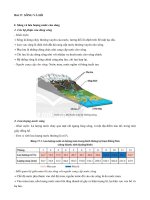Chapter 18: soil properties
Bạn đang xem bản rút gọn của tài liệu. Xem và tải ngay bản đầy đủ của tài liệu tại đây (227.99 KB, 9 trang )
Solutions: Environmental Chemistry - a global perspective 4th Edition
Chapter 18
Soil properties
PROBLEMS/SOLUTIONS
1.
The permeability of the Black Cotton Soils (high in montmorillonite) of the Deccan Plateau in central
India is very high (up to 20 cm h–1) at the beginning of the monsoon season, but soon becomes much
less (below 1 cm h–1) as the rains continue. Suggest an explanation.
Solution
Similar to the Vertisols from the Central Transvaal plateau of South Africa, the permeability of Black
Cotton soils, also a Vertisols, at the beginning of the monsoon season is high (20 cm h -1) because the soil is
dry and full of large cracks. As the rain filters down through the parched and cracked soil, the mineral
montmorillonite hydrates and swells essentially plugging the cracks and passages for any further water to
drain through which decreases the permeability to below 1 cm h-1 (see Table 18.6).
2.
Discuss the types of water contamination problems that are possible when septic tanks for sewage
disposal are located in sandy or in clayey soils.
Solution
Sandy soils
The concern of sandy soils is that permeability is usual very high. This would lead to seepage or runoff of
untreated sewage into local ground water sources, wells, or nearby lakes, rivers or streams. This might lead
to increased nutrient, N or P input to local water systems and lead to increased BOD, rendering the water
unsuitable for recreational use or consumption. As well, elevated levels of faecal matter and coliform or
other pathogenic bacteria may present a potential human heath concern.
Clayey soils
The concern of clayey soils is that permeability is usually very low. This would lead to very poor drainage
and poor aeration of the system. This would cause the stagnant leachate to turn anaerobic producing foul
smells which is usually described as a ‘backed up’ system.
3.
Explain why clay-rich soils have desirable physical and chemical properties for use as liners for
landfill sites.
Solution
Clay rich soils have very low permeability and act as a good physical barrier to liquid transport. In the
event of a chemical contaminant such a toxic metal ion, seeping into the clay barrier, the clay can also
undergo ion exchange releasing a non-toxic cation in place of the now immobilized toxic metal ion.
154
Solutions: Environmental Chemistry - a global perspective 4th Edition
Chapter 18
4.
Soil properties
Consider the following data for a forest soil.
Horizon
Bulk density / g mL–1
Particle density / g mL–1
O (–5 to 0 cm)
0.19
1.78
E (0 to 8 cm)
1.08
2.61
B (42 to 66 cm)
1.52
2.65
Comment on reasons for the differences in values and their significance in terms of porosity and
permeability in each horizon.
Solution
The organic horizon (O) pore space can be calculated using the method shown in example 18.1. The bulk
density is 0.19 g mL-1 and the particle density is 1.78 g mL-1.
0.19
Pore space = 100 – --------- x 100 = 89.3 %
1.78
Similarly, the eluvial horizon (E) pore space is calculated using the bulk density of 1.08 g mL-1 and the
particle density of 2.61 g mL-1.
1.08
Pore space = 100 – --------- x 100 = 58.6 %
2.61
Finally, the B horizon of the forest soil has a pore space calculated using bulk density of 1.52 g mL-1 and
particle density of 2.65 g mL-1.
1.52
Pore space = 100 – --------- x 100 = 42.6 %
2.65
The very large pore space of the ‘light’ 5 cm organic horizon (O) would act to retain some moisture
(sponge like) but also yield a high permeability once saturated. The next 8 cm of the eluvial layer (E) has a
much larger particle density, with a fairly high degree of pore space, and not much structure, leading to a
high permeability. The B horizon at a depth of 42 to 66 cm, which in a forest soil follows the Bhs horizons
where humic material and iron and aluminium oxides are deposited, has less pore space likely due to
compaction. This would likely lead a region that is less permeable.
5.
Salts are commonly spread on highways during winter to prevent build-up of ice. Sodium chloride is
most commonly used, but calcium magnesium acetate (approximately (Ca0.3Mg0.7)(C2H3O2)2) has been
recommended as an alternative because it biodegrades, is less toxic to aquatic life, and is less
corrosive. There is concern, however, that it might increase the mobility of trace metals in roadside
soils. What metals would be of concern and how could these two salts affect their mobility in soils?
155
Solutions: Environmental Chemistry - a global perspective 4th Edition
Chapter 18
Soil properties
Solution
Mobilization of metals could occur through ion exchange processes. In particular it would be Pb that would
be of major concern due to its previous accumulation in roadside soils during the years of using leaded
gasoline. This and other metals such as Cu, Zn, and Ni, associated with the exchangeable sites in the soil
could also be released. Both calcium and magnesium cations are somewhat better than sodium at displacing
exchangeable metals. Therefore, any of these trace metals present, could be released into the solution phase
to a greater extent by the use of the calcium and magnesium containing salt, than by just the sodium salt.
6.
With reference to an ion exchange medium, selectivity refers to the thermodynamic tendency to retain
a particular species. The order of selectivity for alkali metal cations by most clay minerals is
Cs K Na Li
Explain this in terms of the aqueous solution chemistry of these ions.
Solution
The ion size decreases in the order
Cs+ > K+ > Na+ > Li+
181 152 116
90 pm
Since all of the ions have a charge of +1, retention in the order of
Cs+ > K+ > Na+ > Li+
is related to their size, or more specifically their charge density. The smallest cation Li + is the least
retained, but has the highest charge density. As such, H2O (the solvent) which has a high dipole moment,
would be effective in solvating the smaller cation and completely surrounding it, shielding it from the
available exchange sites on the clays. The larger cations would not be as attractive to water (having a lower
charge density) and the negative sites on the clay would be able to compete more readily to retain and
exchange these larger cations.
7.
In soils of the eastern United States, the CEC (cmol (+) kg–1) has been described as related to the OM
(concentration as %) by the equation
CEC 4.83 3.87 OM
with r = 0.73 and N = 57 ( r is the correlation coefficient and N is the number of data points). How
does this relation correspond to the generalities presented in this chapter?
Solution
The equation ‘CEC = 4.83 + 3.87 OM’ suggests that the CEC value is dependent on only one variable –
organic matter content. This would suggest that the clay material (within the soil) is assumed to have a
constant contribution to the CEC value found throughout the eastern United States. Only the variation of
the % OM in the soil would affect the CEC value. From the data, the value of ‘r = 0.73’ for ‘N = 57’, this
may be a reasonable assumption, but there may be particular soil types that would not be well represented
with this simple expression.
156
Solutions: Environmental Chemistry - a global perspective 4th Edition
Chapter 18
8.
Soil properties
10 g of soil were shaken with 100 mL 1 M NH 4OAc, allowed to stand for 2 h, and filtered. 10 mL of
the filtrate was taken and found to have concentrations of 220 ppm Ca 2+, 180 ppm Mg2+, and 270 ppm
K+. What is the CEC of the soil?
Solution
(See/follow Example 18.2)
In this problem we are using 10 g of soil and will therefore divide our result by 10 g to normalize our
results to the 1 g convention.
2(+) x 200 µg Ca2+ mL-1 / 40.1 g mol-1 = 9.98 µmol(+) mL-1 from 10 g soil sample.
Ca:
ữ 10]
= 0.998 àmol(+) mL-1 (from an equivalent 1 g soil sample)
0.998 µmol(+) mL-1 x 100 mL x 1000 g / 1.0 kg soil x 10 -4 cmol / µmol
= 9.98 cmol(+) kg-1 soil
2(+) x 180 µg Mg2+ mL-1 / 24.3 g mol-1 = 14.8 µmol(+) mL-1 from 10 g soil sample.
Mg:
÷ 10]
= 1.48 µmol(+) mL-1 (from an equivalent 1 g soil sample)
1.48 µmol(+) mL-1 x 100 mL x 1000 g / 1.0 kg soil x 10 -4 cmol / µmol
= 14.8 cmol(+) kg-1 soil
1(+) x 270 µg K+ mL-1 / 39.1 g mol-1 = 6.91 àmol(+) mL-1 from 10 g soil sample.
K:
ữ 10]
= 0.691 µmol(+) mL-1 (from an equivalent 1 g soil sample)
0.691 µmol(+) mL-1 x 100 mL x 1000 g / 1.0 kg soil x 10 -4 cmol / µmol
= 6.91 cmol(+) kg-1 soil
CEC = 9.98 + 14.8 + 6.91 = 31.7 cmol(+) kg-1 soil
The CEC of the soil is 31.7 cmol(+) kg-1 soil.
9.
A fraction of soil organic matter was found to have a molar mass of 5000 g mol-1. The organic matter
contained 85 carboxyl groups mol-1 (pKa = 4.8) and 16 phenolic groups mol-1 (pKa = 6.0). At a pH of
7.0, what is the CEC of the organic matter?
Solution
At pH 7.0, it is sufficiently high enough in pH to have most (84.5/85 x 100% = 99%) of the carboxyl
groups deprontonated while the phenolic groups are 14.5/16 x 100% = 91% deprotonated. This amounts to
157
Solutions: Environmental Chemistry - a global perspective 4th Edition
Chapter 18
Soil properties
a total negative charge of 99 mol-1. In 1.0 kg of organic matter, we have a total of 1000 g / 5000 g mol -1 =
0.2 mol, or we have 0.2 mol kg-1.
99(– groups) mol-1 x 0.2 mol kg-1 = 20 (– groups) kg-1.
20(– groups) kg-1 can also be expressed as 20 equivalents (eq) kg-1 and then converted to the traditional unit
of meq (100 g)-1 which is 2000 meq (100 g)-1. The CEC can also be expressed as 2000 cmol(+) kg-1 organic
matter.
10. Logging of a forest by removing all the mature trees is a controversial forestry practice. Aside from
issues such as the effect on species biodiversity and erosion, clear-cutting can alter chemical processes
in the soil and even in the global environment. Explain how this practice could lead to increased
nitrification and denitrification—and how this may affect soil acid–base properties and the
stratospheric ozone concentration.
Solution
Clear-cut logging of a forest can lead to a higher rate of nitrification and denitrification. In such a scenario
there is a large amount of organic matter left to decay on the newly opened forest floor, providing a
plentiful supply of decomposable organic matter.
The first reaction to occur would be ammonification, the conversion of organic matter nitrogen to
ammonium.
2CH3NHCOOH + 3O2 + 2H3O+(aq) 2NH4+(aq) + 4CO2 + 4H2O
At first, the clear-cut area would be aerobic, allowing for the oxidation of the ammonium (under fairly
neutral pH conditions, 6.5 - 8), which is nitrification
NH4+(aq) + 2O2 + H2O NO3-(aq) + 2H3O+(aq)
As this process proceeds, the increase in acid concentration in the soil will slow nitrification, and the
decreased oxygen concentration and high organic matter content will favour the process of denitrification.
4NO3-(aq) + 5{CH2O} + 4H3O+(aq) 2N2 + 5CO2 + 11H2O
Where oxygen is limited or depleted the production of N 2O (g) is possible.
2NO3-(aq) + 2 {CH2O} + 2H3O+(aq) N2O (g) + 2CO2 + 5H2O
The biological production of N2O (g) is the main source for NOx in the stratosphere, as N2O is able to ‘leak’
into the stratosphere (from the troposphere) and react with excited oxygen atoms O(1D).
N2O + O(1D) 2 NO
NO is then involved in a catalytic cycle that reduces the ozone concentration.
158
Solutions: Environmental Chemistry - a global perspective 4th Edition
Chapter 18
Soil properties
NO + O3 NO2 + O2
NO2 + O NO + O2
---------------------------------------O + O 3 2 O2
11. The following are chemical properties of two Venezuelan surface soils. Predict their relative sensitivity
to acidic inputs from rain or fertilizer and give reasons for your prediction.
Soil from
Percentage in soil of
CEC
BS
Clay
Ca
Mg
K
Na
Al
cmol (+) kg–1
%
0.08
7.2
0.3
1.4
0
0.01
0.1
3.7
44
0.17
32.6
6.6
0.9
0.5
0.1
1
8.4
96
pH
OC
N
Machiques
6.0
0.75
Barinas
5.6
1.91
Solution
The Machiques soil would be more sensitive to acid rain inputs. It has a lower CEC and more importantly a
lower base saturation. This indicates that the soil is more susceptible to direct inputs of acid. The Barinas
soil has a CEC value that is mostly due to the base cations with little (4%) contribution from the H +. Any
increase in concentration of H+ would have a more noticeable effect on the pH from the Machiques soil
since the higher pH of 6 is 2.5 times less concentrated in H + than the Barinas soil with a pH of 5.6.
The effect of the addition of fertilizer (NH4+) would have a similar effect on the Machiques soil as the acid
rain. It would be a direct input of ‘acid’ to a soil that is low in nutrients, especially K, where not much
benefit would be gained.
12. In one study it has been shown that soil farmed using conventional tillage is a source to the atmosphere
of 39 kg C ha–1 while, with minimum tillage, the same area is a sink for 11 kg C ha –1. Suggest possible
reasons for these differences.
Solution
The difference between the conventional tillage and minimum tillage with respect to atmospheric C is 50
kg C ha-1.
With conventional tillage, the plough layer would have air (oxygen) to readily react with dead (residual
crop) organic matter and produce carbon dioxide. The minimum (conservation) tillage method promotes
carbon sequestration in the soil organic matter. (for further information try Google search: carbon
sequestration farming tillage).
159
Solutions: Environmental Chemistry - a global perspective 4th Edition
Chapter 18
Soil properties
13. Traditional agricultural methods are used throughout the Zaire river basin and have been described. 1
Comment on the significance of the following practice in terms of soil chemistry and other related
properties.
(a) Land with the thickest vegetation is cleared (by fire) before planting sorghum or manioc.
(b) Several crops are grown together or in sequence in the same area, so that the land is covered with
vegetation over an extended period of time.
(c) Household waste, sod, and dry grass are incorporated into the soil before or after planting.
Sometimes the compost is incinerated in mounds, later used for planting root crops such as yams.
(d) In some areas, nomadic communities are invited (sometimes even paid) to set up temporary animal
corrals after which the site used for cropping.
Solution
(a) Using fire is an efficient method of clearing the land. The residual ash retains some of the nutrients in
the original plant material - particularly phosphorus and potassium, but other nutrients (most notably
nitrogen) are lost through volatilization. Furthermore, to some degree soil organic matter is destroyed,
reducing nutrient and water holding capacity.
(b) This is desirable from the point of view of minimizing erosion. Nutrient control is important, and it is
desirable to return crop residues to the soil as much as possible.
(c) The cycling of nutrients in soil organic matter is important. If fresh OM is incorporated in the soil, it
may immobilize nitrogen for some time, due to the nutritional requirements of the organisms involved in
decomposing the OM. The incinerated compost supplies some essential elements, but not others as noted
in part a.
(d) This common practice is highly sustainable as a means of weed control and as a source of organic
matter and nutrients from the animal manure.
14. The planting of high-yielding hybrid varieties of grains is widespread and has contributed to increasing
the global grain supply. A co-requirement is the application of large amounts of fertilizer to support the
high levels of growth. For example, corn (maize) yields of greater than 20 t ha –1 are obtainable under
good agronomic conditions. This might require the addition of 500 kg ha–1 of nitrogen in the form of
urea. Calculate the amount (kg ha –1) of limestone (CaCO3) that should be added to the soil just to
balance the acidity generated by this fertilizer, assuming complete nitrification of the urea.
Solution
(NH2)2CO – urea would under go the following sequence of reactions:
hydrolysis
protonation
1
(NH2)2CO + H2O 2NH3 + CO2
2NH3 + 2H3O+ 2NH4+ + 2H2O
Miracle, M.P., Agriculture in the Congo Basin, University of Wisconsin Press, Madison, Wisconsin; 1967.
160
Solutions: Environmental Chemistry - a global perspective 4th Edition
Chapter 18
nitrification
net result:
Soil properties
2NH4+ + 4O2 + 2H2O 2NO3- + 4H3O+
------------------------------------------------------------------------------(NH2)2CO + H2O + 4O2 2NO3- + 2H3O+ + CO2
The net acid production from the addition of urea as a fertilizer to the soil is 2 moles of H + for each mole of
urea.
Assuming 1 ha coverage,
500 kg ha-1 (N) x 1 ha = 500 kg N
500 kg N x 1000 g kg-1 = 500 000 g N
500 000 g N 14 g mol-1(N) = 35 714 mol of N
The net equation shown above indicates that 1 mol of H3O+ is generated from each mol of N added as urea.
Therefore 500 kg N (as urea) produces 35 714 mol H3O+.
The amount of limestone (CaCO3, 100 g mol-1) required to balance this acidity is:
35 714 mol of H3O+ 2 = 17 857 mol of CaCO3
17 857 mol of CaCO3 x 100 g mol-1 = 1 785 714 g CaCO3
(per ha)
Therefore the amount of limestone required to completely balance the addition of 500 kg of N (in the form
of urea) per ha is 1786 kg. (or ~ 1.8 t ha -1).
15. Elemental sulfur is sometimes used for neutralizing the alkalinity in sodic soils. Write the equation for
the oxidation of sulfur to its stable aerobic form, and calculate the amount of sulfur required to
‘neutralize’ every kg of sodium carbonate in the soil.
Solution
Sulfur’s stable aqueous aerobic form is SO42- (aq), see Chapter 10, Figure 10.5
microorganism
S (s) + O2 (g) + 2 H2O (l)
→
H2SO4 (aq)
mediated
H2SO4 (aq) + Na2CO3 (s)
→
Na2SO4 (aq) + H2O (l) + CO2 (g)
The molar ratio of Na2CO3 to S is 1:1. 1.0 kg of Na2CO3 is 9.44 moles, which means 9.44 moles of S are
needed to completely neutralize it.
9.44 mol S x 32.06 g mol-1 = 303 g S.
The amount of S needed to ‘neutralize’ every kg of sodium carbonate in the soil is approximately 0.3 kg.
161
Solutions: Environmental Chemistry - a global perspective 4th Edition
Chapter 18
Soil properties
16. Soils in the Mekong Delta of South-East Asia are maintained in a submerged state and are used for
growing rice. These soils formed on marine deposits that are rich in pyrite. What chemical changes
would be expected when these soils are drained in order to grow a different crop?
Solution
Pyrite (FeS2) will be very stable under the reducing conditions that obtain in the submerged soils needed for
growing rice. However, if these soils are drained and exposed to the air (oxygen), the pyrite will undergo
oxidation and release acidity to the soil. This will need to be treated in order for the soil to be productive. A
similar scenario is provided in the text, Chapter 19, Tailing from sulphide ore deposits in Section 19.1,
when discussing tailings from sulphide ore deposits. See Reactions 19.1-19.7.
162









